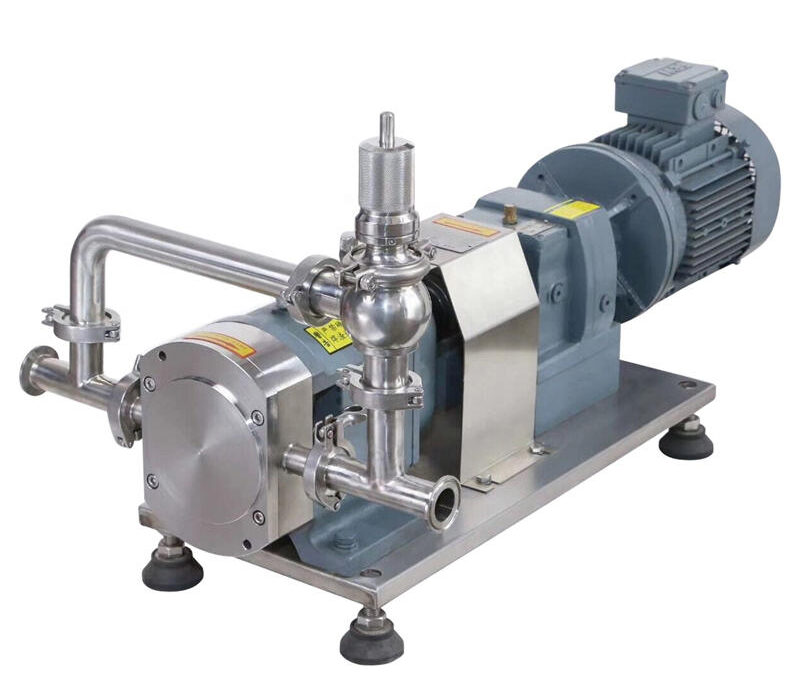Lobe pumps are among the most effective and reliable solutions for transferring various types of fluids, particularly those that are thick or sensitive to shear forces. These pumps have gained prominence in several industries, including food processing, pharmaceuticals, and chemical manufacturing. This article aims to provide a comprehensive understanding of lobe pump, their functionality, applications, benefits, and key considerations for selection.
The Mechanics of Lobe Pumps
Lobe pumps operate using a unique mechanism that involves rotating lobes. Typically, these pumps feature two or more lobes that rotate within a chamber, creating a series of pockets. As the lobes turn, they draw fluid into the pump and subsequently push it out through the discharge outlet. This positive displacement action ensures a steady flow of fluid, regardless of changes in pressure conditions.
One of the defining characteristics of lobe pumps is their ability to handle fluids with varying viscosities. Because the lobes do not touch each other, there is minimal friction and wear, allowing for a gentle transfer of sensitive materials. This makes lobe pumps particularly well-suited for applications requiring low shear, thus preserving the integrity of the fluid being pumped.
Diverse Applications of Lobe Pumps
Lobe pumps are versatile and widely utilized across various industries. In the food and beverage sector, they excel in transferring products like sauces, dressings, and dairy formulations. Their gentle pumping action ensures that the quality and texture of these products are maintained, making them ideal for high-viscosity applications.
In the pharmaceutical industry, lobe pumps are essential for handling delicate formulations, such as emulsions and suspensions. The low shear characteristics of these pumps ensure that active ingredients remain intact and effective. This is crucial in maintaining the quality and efficacy of pharmaceutical products.
The chemical industry also benefits from the robust design of lobe pumps, particularly for transporting corrosive or abrasive fluids. Made from durable materials like stainless steel, these pumps can withstand harsh environments while providing consistent and reliable performance. Additionally, in cosmetics, lobe pumps are used to transfer creams and lotions, where precision and cleanliness are of utmost importance.
Advantages of Lobe Pumps
Lobe pumps offer several key advantages that make them a preferred choice in many applications. One of the most significant benefits is their capability to handle a wide range of viscosities. Unlike centrifugal pumps, which may struggle with thick or sticky fluids, lobe pumps can efficiently transfer both low and high-viscosity materials.
Another advantage is the precise flow control provided by lobe pumps. This level of precision is essential in applications requiring accurate dosing and mixing, helping to minimize waste and ensure compliance with strict quality standards. Furthermore, lobe pumps are energy-efficient, contributing to lower operational costs over time.
The design of lobe pumps also facilitates easy cleaning, which is vital in industries where hygiene is a priority. Many lobe pumps are engineered for quick disassembly, allowing for efficient maintenance and cleaning processes.
Comparing Lobe Pumps with Other Pump Types
When evaluating lobe pumps, it is helpful to compare them with other types of pumps. For instance, centrifugal pumps rely on velocity to move fluids and may not perform effectively with viscous materials. In contrast, lobe pumps utilize positive displacement, making them more suitable for transferring thick fluids.
Additionally, when compared to gear pumps, lobe pumps provide a gentler pumping action, reducing the risk of damaging sensitive materials. Gear pumps often create high shear forces, which can compromise the integrity of delicate products. Lobe pumps, on the other hand, minimize shear stress, making them a better option for applications involving sensitive fluids.
Selecting the Right Lobe Pump
Choosing the appropriate lobe pump involves several critical considerations. First, assess the viscosity of the fluid to be pumped. Lobe pumps are available in various configurations tailored to different viscosity levels, so understanding your material is essential for optimal performance.
Next, determine the required flow rate and pressure. Lobe pumps can accommodate flow rates of up to 100 m³/h, but selecting a pump that meets your specific needs is crucial. Additionally, consider the materials of construction; stainless steel options are common in lobe pumps due to their durability and resistance to corrosion.
It is also important to evaluate the cleaning and maintenance requirements. In industries with stringent hygiene standards, pumps that can be easily disassembled and cleaned are preferred. Many lobe pumps are designed with these considerations in mind, ensuring quick maintenance and minimal downtime.
Conclusion
In conclusion, lobe pumps are an essential technology in various industries, providing efficient and reliable solutions for transferring viscous and sensitive materials. Their unique design allows for precise flow control and minimal shear stress, making them ideal for applications in food, pharmaceuticals, chemicals, and cosmetics.
For those seeking high-quality lobe pumps, the Ace Rotary Lobe Pump is a leading brand in China. With over 22 years of experience, Ace specializes in delivering customized pumping solutions that cater to the diverse needs of clients across multiple sectors. Their commitment to quality, reliability, and customer satisfaction establishes them as a trusted partner for businesses requiring dependable pumping solutions.
To explore more about lobe pumps and discover a range of products, visit our website. Learn how their innovative technology can enhance your operational efficiency while ensuring the quality of your products.





